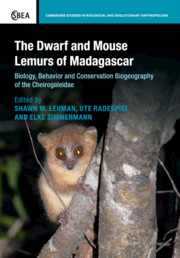 The Dwarf and Mouse Lemurs of Madagascar
The Dwarf and Mouse Lemurs of Madagascar from Part III - Cheirogaleidae: behavior and ecology
Published online by Cambridge University Press: 05 March 2016
Introduction
Competition over resources, both between individuals of the same species and between different species, plays a crucial role in natural selection (Danchin et al., 2008). Competition is believed to play a major role in regulating the local coexistence of individuals and species (Gause, 1934); therefore, adaptations should have evolved to reduce intra- as well as interspecific resource competition (review in Gause 1934; Brown and Wilson 1956; Hardin 1960; Amarasekare, 2003; Chase and Leibold, 2003). In principle, competition can be avoided through resource partitioning (arthropods: Behmer and Joern, 2008; invertebrates: Pianka, 1973; birds: Garcia and Arroyo, 2005; mammals: Azevedo et al., 2006; Sushma and Singh, 2006). Partitioning of food resources (of focus in this chapter) can be expressed in different ways. First, a food resource might be used by several individuals and/or species in different proportions. For instance, even though three sympatric primate species in Bolivia (Callimico goeldii, Saguinus labiatus and S. fuscicollis) show dietary overlaps, the relative proportion of shared food resources in their total diet differ between species (Porter, 2001). Second, food resources might be temporally partitioned: shared resources may be used at different times of the day and/or during different seasons. This is illustrated by the diurnal versus the nocturnal feeding patterns of different lemur species in Madagascar (Petter, 1962), as well as the varying levels of nocturnal activity between two sympatric species of foxes in Brazil (Vieira and Port, 2007). Third, food resources might be spatially partitioned. The same resources can then be used by competitors who occupy different areas or microhabitats. Spatial separation of resources can occur on a local scale as well as on a larger geographic scale. One example is given by two mouse lemur species, Microcebus murinus and M. berthae, in western Madagascar. These solitary foragers show a high degree of dietary overlap, but their coexistence appears to be facilitated by spatial separation on a local scale (Dammhahn and Kappeler, 2008a, 2008b). On an intraspecific level, spatial separation is most prominent in territorial species where individuals exclude each other from access to the resources within their territories, and reduce direct competitive interactions by marking them with olfactory cues (Paquet, 1991; Fawcett et al., 2012), acoustic signals (Chivers and MacKinnon, 1977; Robinson, 1981) or visual displays (Peek, 1972).
To save this book to your Kindle, first ensure [email protected] is added to your Approved Personal Document E-mail List under your Personal Document Settings on the Manage Your Content and Devices page of your Amazon account. Then enter the ‘name’ part of your Kindle email address below. Find out more about saving to your Kindle.
Note you can select to save to either the @free.kindle.com or @kindle.com variations. ‘@free.kindle.com’ emails are free but can only be saved to your device when it is connected to wi-fi. ‘@kindle.com’ emails can be delivered even when you are not connected to wi-fi, but note that service fees apply.
Find out more about the Kindle Personal Document Service.
To save content items to your account, please confirm that you agree to abide by our usage policies. If this is the first time you use this feature, you will be asked to authorise Cambridge Core to connect with your account. Find out more about saving content to Dropbox.
To save content items to your account, please confirm that you agree to abide by our usage policies. If this is the first time you use this feature, you will be asked to authorise Cambridge Core to connect with your account. Find out more about saving content to Google Drive.